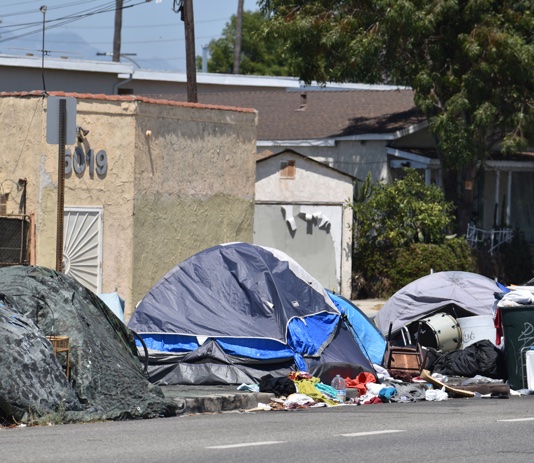by Alberto Galvi –
SAN LUIS OBISPO (USA). California is the most populous state in the US and if it were an independent nation it would be the fifth largest economy in the world, just after Germany but ahead of India. The Golden State also has lackluster firsts. It represents 12 percent of the US population, but includes 30 percent of the country’s homeless. It is estimated that more than 160,000 residents have no fixed abode. They are obviously concentrated in big cities like San Francisco and Los Angeles. Some sleep on sidewalks, under bridges, in illegal camps, in parks and even in cars.
This scourge creates for California the image of a state in chaos, but in reality it is a phenomenon that afflicts the whole country. Some would believe that, considering the state’s relatively mild climate, the homeless may have come from other states. A study by the University of California at San Francisco reports that 90 percent of them already resided in the state and that 70 percent are in the same county where their last home was.
However, the main reason for the high homelessness rate lies in the shortage of public housing. Larger Californian cities such as Los Angeles and especially San Francisco are very expensive and the number of accommodations available is far from sufficient. Some analysts use the children’s game of chairs as an analogy to explain the phenomenon. As soon as the game begins, one of them is slower, limps, or gets hurt and is left without a chair. The child excluded from the game is “evicted” by another a little faster. Someone has to stay outside because there aren’t chairs for everyone. The same thing happens with housing.
The loss of housing typically occurs for many reasons but at the root of it all is the fact of the lack of available homes at affordable prices. How do you become homeless? Home loss is often linked to poverty, rent increases, domestic violence, divorce, drug or alcohol use, or mental illness. Once on the street the poor people survive as best they can. They sleep on sidewalks, under bridges, in illegal camps, or in public parks. In California, homeless people can only be arrested if they commit felonies. By law, however, they cannot be criminalized for the simple fact of not having a home. The Martin vs. Boise and the ensuing decision of the Federal Court of the Ninth District which covers California and several western states. The homeless can be moved from one place to another but the government must offer a reasonable alternative. What is this alternative about? It could be a shelter, a dormitory, an apartment or some other situation that at least temporarily fixes their tragic situation.
The visibility of homelessness in California, a liberal state with a Democratic governor and both legislative houses, obviously causes consternation and provides an excuse for conservative state governors to repeat the line that the Golden State would be better governed if Republicans were in charge. They point to the number of homeless people in some states with rates lower than California’s. The case of West Virginia is often cited. Very poor state with very high poverty rates but low homelessness rates compared to California. The difference, however, remains the availability and demand for housing. San Francisco is much more attractive than West Virginia. In addition, there are jobs in California that pay better but not enough considering the very strong demand for housing. It is a gap between demand and availability of housing. It also happens in Italy, especially in Milan and in other big cities where quite a few students have recently pitched tents in front of their universities to protest against high rents.
In California, however, some universities have tried to accommodate their homeless students by allowing those who sleep in their cars to park in university spaces where they can access bathrooms, electricity, and other basic services, facilitating their studies. But it is a patch. The problem is much more serious and Governor Gavin Newsom has announced a plan to increase the number of public housing by allocating $12 billion. The funds would be used to build public housing and expand mental health services.
Newsom’s initiative could lead to significant improvements as the example of the Housing First concept already indicates. The city of Houston in Texas has implemented it, where from 2011 to today the number of homeless people has been reduced by 63 percent. The local government has managed to expand the number of houses significantly by taking advantage of the relatively low rules for building new residences. California and other liberal states with very strict rules for new construction projects will have to ease them. It won’t be easy because in the US there is the concept of the American dream of owning one’s own single family home. Suffice it to recall that 70 percent of homes in Los Angeles are single-family homes. The state government will also face a myriad of local ordinances that prevent the easy construction of new homes but also limit the increase in density to make a major impact and reduce the plight of homelessness.
*Domenico Maceri, PhD, is professor emeritus at Allan Hancock College, Santa Maria, California. Some of his articles have won awards from the National Association of Hispanic Publications.
